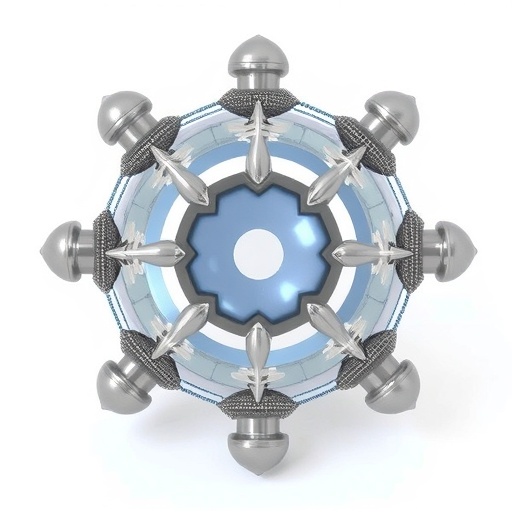
In the relentless pursuit of advanced materials capable of withstanding hydrogen embrittlement (HE), a formidable challenge in metals engineering, researchers have propelled aluminum alloys to new heights through a sophisticated approach known as structurally complex phase engineering. This breakthrough, detailed in a recent Nature publication by Jiang et al., unveils how a precise control over nanoprecipitate size distribution within aluminum alloys orchestrates a delicate balance between mechanical strength and hydrogen tolerance, promising transformative implications for industrial applications.
At the core of this innovation lies the discovery that aluminum-scandium (Al–Sc) based alloys exhibit a dual distribution of nanoprecipitates that fundamentally governs their performance under hydrogen exposure. These nanoprecipitates, minuscule particles embedded within the aluminum matrix, exist primarily in two distinct size regimes. Nanoparticles below 10 nanometers, predominantly composed of Al₃Sc, are instrumental in delivering enhanced strength by impeding dislocation motion. Simultaneously, larger nanoprecipitates exceeding 10 nanometers, characterized by a composite phase of Al₃(Mg,Sc)₂ combined with Al₃Sc, emerge as critical players in conferring resistance to hydrogen embrittlement.
This size-dependent phase transformation epitomizes the delicate interplay of microstructural features tailored through meticulous alloy design and thermomechanical processing. Researchers demonstrated that the coexistence of fine Al₃Sc and larger Al₃(Mg,Sc)₂/Al₃Sc nanoprecipitates is essential to achieve the coveted synergy between strength and HE resistance. Absent this dual distribution, neither property can be simultaneously optimized, highlighting a fundamental scaling law that governs the structuring of high-performance Al alloys.
From a materials engineering perspective, the optimal nanoprecipitate size cluster centers around 20 nanometers, with a margin of ±10 nanometers, to maximize the complementary benefits. Smaller precipitates primarily obstruct dislocation motion, bolstering tensile strength, while the larger precipitates, by virtue of their structural complexity and volume fraction, act as robust hydrogen traps that mitigate embrittlement. Such precision in size control is non-trivial, demanding exacting control over composition, heat treatment duration, and cooling rates.
Magnesium content further emerges as a pivotal variable, spanning an effective range between 4.5 to 7.5 weight percent. Within this compositional window, alloys sustain comparable hydrogen embrittlement resistance with the benchmarked 6.0 weight percent Mg composition, suggesting flexibility in alloy design without sacrificing performance. This adaptability enhances the prospect of tailoring alloys for specific applications or processing constraints, expanding the palette available to engineers.
The kinetics of the precipitation reaction introduce an additional layer of complexity. Being diffusion-mediated, the heat treatment duration imposes a decisive influence on nanoprecipitate evolution. Empirical studies elucidate that after approximately 36 hours, the measure of precipitation stabilization, denoted as κ, plateaus prematurely, resulting in suboptimal HE resistance. Extending the heat treatment to 72 hours further refines precipitate characteristics, enhancing the protective effect against hydrogen ingress while preserving mechanical integrity.
Importantly, this paradigm is not confined solely to Al–Mg–Sc alloys. The research team validated the generalizability of their approach by successfully substituting scandium with equiatomic quantities of titanium and zirconium in twin-roll cast Al–Mg–Ti–Zr alloys. This substitution not only maintains the dual nanoprecipitate distribution essential for HE resistance but also offers sound economic alternatives given the relative scarcity and cost of scandium. Likewise, incorporating copper into Al–Mg–Cu–Sc alloys yielded pronounced strength enhancements, while adding trace amounts of zinc in Al–Mg–Zn–Sc alloys fortified the mechanical responses further, illustrating the versatility of this designing principle across various alloy families.
A particularly noteworthy milestone is the viable scale-up of the Al–Mg–Sc-II alloy production using water-cooled copper mould casting combined with optimized thermomechanical processing. This advancement indicates strong potential for industrial adoption, cracking the formidable barrier between laboratory innovation and large-scale manufacturing feasibility. Remarkably, the scaled alloy not only preserved robust HE resistance comparable to small-scale counterparts but also exhibited an approximately 10% increment in tensile strength, an exceptional feat in alloy engineering.
Beyond conventional alloy compositions, this structurally complex phase engineering strategy portends breakthroughs in emerging classes of aluminum alloys, including crossover alloys blending multiple high-performance elements, as well as novel alloys synthesized via additive manufacturing techniques. These advances could accelerate the development of ultrahigh-strength, hydrogen-tolerant aluminum materials critical for demanding sectors such as aerospace, automotive, and energy storage, where hydrogen exposure is prevalent.
The success of this methodology is anchored in a thorough understanding of nanoscale phase transformations coupled with precision control over alloy chemistry and thermal history. It underscores the transformative power of microstructure engineering, where manipulating atomic-scale features delivers macroscopic enhancements, enabling engineers to surmount traditional tradeoffs between strength and degradation resistance.
In essence, Jiang and colleagues have charted a blueprint for the next generation of aluminum alloys, weaving intricate nanoscale architectures that simultaneously harden the metal and shield it against hydrogen-induced failures. The dual nanoprecipitate distribution concept spearheads a shift in alloy design philosophy, steering materials science towards structural complexity as a pragmatic avenue for resolving enduring challenges in metal performance.
This work further illuminates the path toward sustainable hydrogen technologies, where durable, lightweight materials are imperative to a future dominated by clean energy. By safeguarding aluminum alloys against hydrogen embrittlement without compromising strength, this research bridges a critical gap, bringing us closer to a resilient hydrogen economy fortified by intelligent materials design.
As the realm of materials science delves deeper into the territory of multi-phase nanoscale architectures, innovations typified by this study will redefine the boundaries of metallic systems’ capabilities. The convergence of alloy chemistry, thermomechanics, and nanoscale structural control offers a fertile landscape for future breakthroughs, ensuring that the aluminum alloys of tomorrow are not only stronger but also smarter and more resilient.
Subject of Research:
Hydrogen embrittlement resistance and mechanical strengthening through nanoscale phase engineering in aluminum-scandium alloys and their derivatives.
Article Title:
Structurally complex phase engineering enables hydrogen-tolerant Al alloys.
Article References:
Jiang, S., Xu, Y., Wang, R. et al. Structurally complex phase engineering enables hydrogen-tolerant Al alloys. Nature (2025). https://doi.org/10.1038/s41586-025-08879-2
Image Credits: AI Generated
Tags: advanced materials for industrial applicationsaluminum alloy advancements in engineeringaluminum-scandium alloy performancedual nanoprecipitate distribution in alloyshydrogen embrittlement resistance in aluminum alloyshydrogen exposure in metals engineeringinnovative alloy design strategiesmechanical strength vs. hydrogen tolerancemicrostructural features in alloysnanoprecipitate size distribution effectsphase engineering in materials sciencethermomechanical processing techniques





